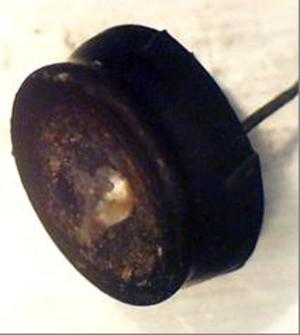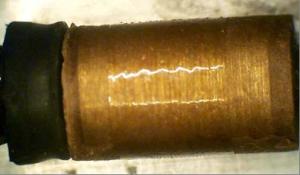Electrolytic Capacitor Failure
Gideon Analytical Laboratories received a single capacitor for failure analysis. The capacitor had a capacitance of 22µF, a voltage rating of 400 V, was ROHS compliant and had a vented bottom and the wound was exposed. The goal was to determine the cause of the failure.
The capacitor sleeve was not cracked and bulging was not apparent. This usually indicates the failure occurred during a minor period from onset of the pressure build up within the can. As can be seen in the picture at the top left, the anode has corroded through the aluminum tab. The lead consists of the tin plated copper clad iron, brazed to an aluminum socket, which consists of a shank and aluminum tab. The gray material on the lead is aluminum hydroxide, the by-product of corrosion. The silver colored material is aluminum. The light brown material is the solute that has precipitated out of the electrolyte solution. There was solvent on the wound circumference.
This failure happened quite rapidly since the onset of the corrosion. This is supported from two factors; residual solvent and the aluminum can did not bulge, thus cracking the sleeve. The solvent can be seen in the picture at the top right. SEM-EDS analysis was conducted, which revealed the presence of chlorides.
Gideon Analytical Laboratories concluded that the capacitor vented due to hydrogen build up. This happens because of concurrent reforming of the corrosion by- product at the same time corrosion is depleting the aluminum lead. It happens fast and is limited by the amount of aluminum present in the lead and the path it takes. It always results with an open anode lead. The presence of calcium on both the anode and cathode lead suggested a contamination issue; the presence of chlorides on the anode suggested the corrosion was caused by chloride.
Gideon Analytical Laboratories strives to identify how and why devices are failing, both in the manufacturing process and in field applications. This information can help companies in the electronics industry can save enormous amounts of time and money. It is the goal of Gideon Analytical Laboratories to provide accurate analytical results that can help a company solve problems and better prepare for future business.

End seal showing chemical deposition

Kraft paper showing signs of heat damage